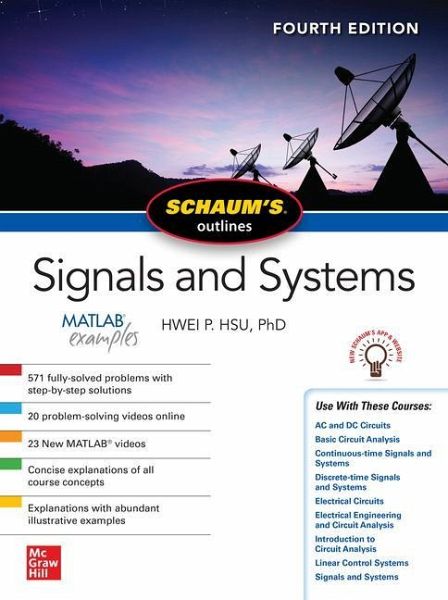
Schaum's Outline of Signals and Systems, Fourth Edition
Versandkostenfrei!
Versandfertig in 2-4 Wochen
25,99 €
inkl. MwSt.

PAYBACK Punkte
13 °P sammeln!
Publisher's Note: Products purchased from Third Party sellers are not guaranteed by the publisher for quality, authenticity, or access to any online entitlements included with the product. Tough Test Questions? Missed Lectures? Not Enough Time? Textbook too Pricey? Fortunately, there's Schaum's. More than 40 million students have trusted Schaum's to help them succeed in the classroom and on exams. Schaum's is the key to faster learning and higher grades in every subject. Each Outline presents all the essential course information in an easy-to-follow, topic-by-topic format. You also get hundred...
Publisher's Note: Products purchased from Third Party sellers are not guaranteed by the publisher for quality, authenticity, or access to any online entitlements included with the product. Tough Test Questions? Missed Lectures? Not Enough Time? Textbook too Pricey? Fortunately, there's Schaum's. More than 40 million students have trusted Schaum's to help them succeed in the classroom and on exams. Schaum's is the key to faster learning and higher grades in every subject. Each Outline presents all the essential course information in an easy-to-follow, topic-by-topic format. You also get hundreds of examples, solved problems, and practice exercises to test your skills. Schaum's Outline of Signals and Systems, Fourth Edition is packed hundreds of examples, solved problems, and practice exercises to test your skills. This updated guide approaches the subject in a more concise, ordered manner than most standard texts, which are often filled with extraneous material. Schaum's Outline of Signals and Systems, Fourth Edition features: ¿ 571 fully-solved problems ¿ 20 problem-solving videos¿ 23 MATLAB videos ¿ Additional material on matrix theory and complex numbers ¿ Clear, concise explanations of all signals and systems concepts ¿ Content supplements the major leading textbook for signals and systems courses ¿ Content that is appropriate for Basic Circuit Analysis, Electrical Circuits, Electrical Engineering and Circuit Analysis, Introduction to Circuit Analysis, AC and DC Circuits courses PLUS: Access to the revised Schaums.com website and new app, containing 20 problem-solving videos, and more. Schaum's reinforces the main concepts required in your course and offers hundreds of practice exercises to help you succeed. Use Schaum's to shorten your study time-and get your best test scores! Schaum's Outlines-Problem solved.












